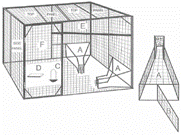Eastern Wildlife Damage Control Conferences

Eastern Wildlife Damage Management Conference: 8th (1997)
Date of this Version
October 1997
Document Type
Article
Abstract
Previous research on deer repellents by the authors suggests that visual cues (warnings) coupled with application of an effective repellent may enhance the protection afforded by the repellent. We report the results of 2 separate experiments designed to evaluate and partition the effects of such visual cues in practical applications of 3 candidate repellents. In the first experiment, we established 1-ha plots in late succession old fields in Warren County, New Jersey. Plots were treated with bobcat urine, Deer Stopper®, water, and no treatment. Treatment application was made to 5-cm strips of cotton cloth attached to ¼-in cotton rope that encircled the entire plot. Strips were placed at 10-cm intervals. Browsing by deer in these plots was monitored for 1 year. The proportion of stems browsed relative to those available was recorded from randomly chosen 1-m x 100-m sample strips (2 per plot per month). Red maple (Acer rubrum), blueberry (Vaccinium spp.), and black gum (Nyssa sylvatica) predominated in a mix of 16 woody species. Overall, browsing rates showed little seasonal change, but were affected by treatments: control (no treatment)-31%; rope only-18%; bobcat urine-10%; and Deer Stopper® -2%. Duncan’s multiple range test indicates a difference between all treatment except bobcat urine and Deer Stopper®. In the second experiment, using Big Game Repellent® (BGR) and Deer Stopper®, these results were confirmed and extended. In situations where deer can make an association of the repellent with a visual cue, they do so. The effect of the combination is both desirable and measurable.


Comments
Published in Proceedings of the Eighth Eastern Wildlife Damage Management Conference, Roanoke, Virginia, October 16–19, 1997, edited by James A. Parkhurst. Copyright © 1997 by the authors.